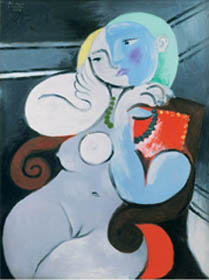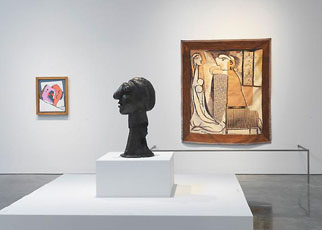 The
Gallery Gazetteer
The
Gallery Gazetteer 
"Picasso and Marie-Thérèse: L’amour
fou," an intimate journey of Picasso's art
by Agate Elie
"Picasso and Marie-Thérèse:
L’amour fou"
The Goagosian Gallery, www.gagosian.com
522 West 21st Street, New York, NY 10011
Monday to Saturday, 10am to 6pm
April 14 to June 25
Reviewed by Agate Elie on May 5, 2011
 |
| Pablo
Picasso-- Femme nue dans un fauteuil rouge, 1932. |
With "Picasso and Marie-Thérèse:
L'amour fou," the Gagosian Gallery, situated in Chelsea, brings
us into the secret intimacy of Pablo Picasso, the man and the artist.You
don't have to be French to understand "Crazy love," the
meaning of "l'amour fou," and why it is a fitting
title for the exhibition. The entire gallery is filled up with renderings
of Marie-Thérèse in drawings, paintings and sculptures
from 1927 to 1940. Picasso's love leaks out of each piece of art.
While Picasso was a successful artist, he maintained
a secret life with Marie-Thérèse Walter; an 18 year
old woman he met in a street of Paris. Her "interesting face,"
as Picasso says, inspired him and she became his muse.
Picasso's art expresses very well the intriguing
face of Marie-Thérèse. She is not typical with her
large nose, curving lips, round face, ungraceful chin and intense
almond shaped blue eyes. But her beauty emerges in Picasso's hands.
The canvas "Femme nue dans un fauteuille rouge"
represents a naked woman in a red sofa which is obviously Marie
Thérèse. Picasso, in this canvas and few others, painted
his muse using round shapes and soft angles with pastel colors.
Marie-Thérèse emanates calm, kindness, youth and pure
beauty. He also painted her in a reading position and writing letters,
showing an educated and smart woman.
Picasso returned to sculpture in the period covered
by this exhibit and created simplistic portraits of Marie Thérèse.
Most of the sculptures date from the 1930's, but one of them, signed
in 1973 called "Tête de femme," is very
surprising. We recognize her features but she is distorted. Her
eyes are coming out; a hook nose and a jutting chin exaggerate her
face. I could not stop wondering why in 1973, the year of his death,
he sculpted Marie-Thérèse that way.
 |
| Sculpture
"Tête de femme" date 1973. Photo by
Rob McKeever. |
Talking about surprises, "La sièste"
and "Deux femmes enlacées" were very intriguing.
"La sièste" represents a woman sleeping.
He uses three main light colors: blue, green and purple. The painting
style and colors reminded me of "The Dance" by Matisse.
"La sièste" is a very spectacular piece
of art that traps your attention for a while. The same thing happens
with "Deux femmes enlacées," dated 1936,
which according to the title, is supposed to represent two intertwined
women. But when you look at the painting, a third women appears
to you in the middle of the embracing scene. Why call it "Deux
femmes enlacées" when there is a third one?
 |
 |
Pablo
Picasso-- La sieste, August 18, 1932.
|
Pablo
Picasso-- Deux femmes enlacées, April 29, 1936. |
The exhibit is a journey in which you can discover
once again Picasso's talent in a way that will move and challenge
you. It ends with a quote by Picasso that is worth reading, which
is a beautiful conclusion to this intimate exhibition devoted to
Marie-Thérèse Walter: "I love you more than the
taste of your mouth, more than your look, more than your hands,
more than your whole body, more and more and more than all my love
for you will ever be able to love and I sign Picasso."
Photo Credits: Femme nue dans
un fauteuil rouge © 2011 Estate of Pablo Picasso/Artists
Rights Society (ARS), New York. Image: © Tate, London 2011.
Courtesy Gagosian Gallery. La sièste © 2011
Estate of Pablo Picasso/Artists Rights Society (ARS), New York.
Photo: © P.A.R. Photo: Eric Baudouin. Courtesy Gagosian Gallery.
Deux femmes enlacées © 2011 Estate of Pablo
Picasso/Artists Rights Society (ARS), New York. Photo by Studio
Patrick Goetelen. Courtesy Gagosian Gallery.